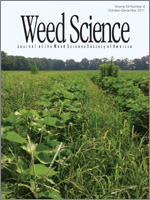Crowfootgrass, a C4 species, is one of the principal weeds of dry-seeded rice in Asia. Weed management decisions for this species can be derived from knowledge of its seed germination biology. Experiments were conducted in the laboratory and screenhouse to determine the effects of light, alternating day/night temperatures, water stress, seed burial depth, and rice residue on seed germination and seedling emergence of crowfootgrass and to evaluate the response of this weed to commonly available selective POST herbicides in the Philippines. Light stimulated seed germination, but it was not an absolute requirement for germination. Germination in the light/dark regime was greater at alternating day/night temperatures of 25/15 C (92%) than at 30/20 (70%) or 35/25 C (44%). The osmotic potential required for 50% inhibition of maximum germination was −0.23 MPa, although some seeds germinated at −0.6 MPa. Seedling emergence was greatest for the seeds placed on the soil surface (64%), and emergence declined with increased burial depth in soil. No seedlings emerged from a burial depth of 6 cm or greater. Seedling emergence of crowfootgrass was reduced by the addition of rice residue to the soil surface at rates equivalent to 4 to 6 Mg ha−1. Fenoxaprop-p-ethyl ethoxysulfuron at 45 g ai ha−1 provided excellent control of crowfootgrass when applied at the four- (99%) and six-leaf (86%) stage. The information gained from this study could contribute to developing components of integrated weed management strategies for crowfootgrass. Soil inversion by tillage to bury weed seeds below their maximum depth of emergence, use of crop residue as mulch, and early application of an effective POST herbicide could serve as important tools for managing crowfootgrass.
Nomenclature: Bispyribac-sodium; fenoxaprop-p-ethyl ethoxysulfuron; penoxsulam cyhalofop; crowfootgrass, Dactyloctenium aegyptium (L.) Willd. DTTAE; rice, Oryza sativa L.





